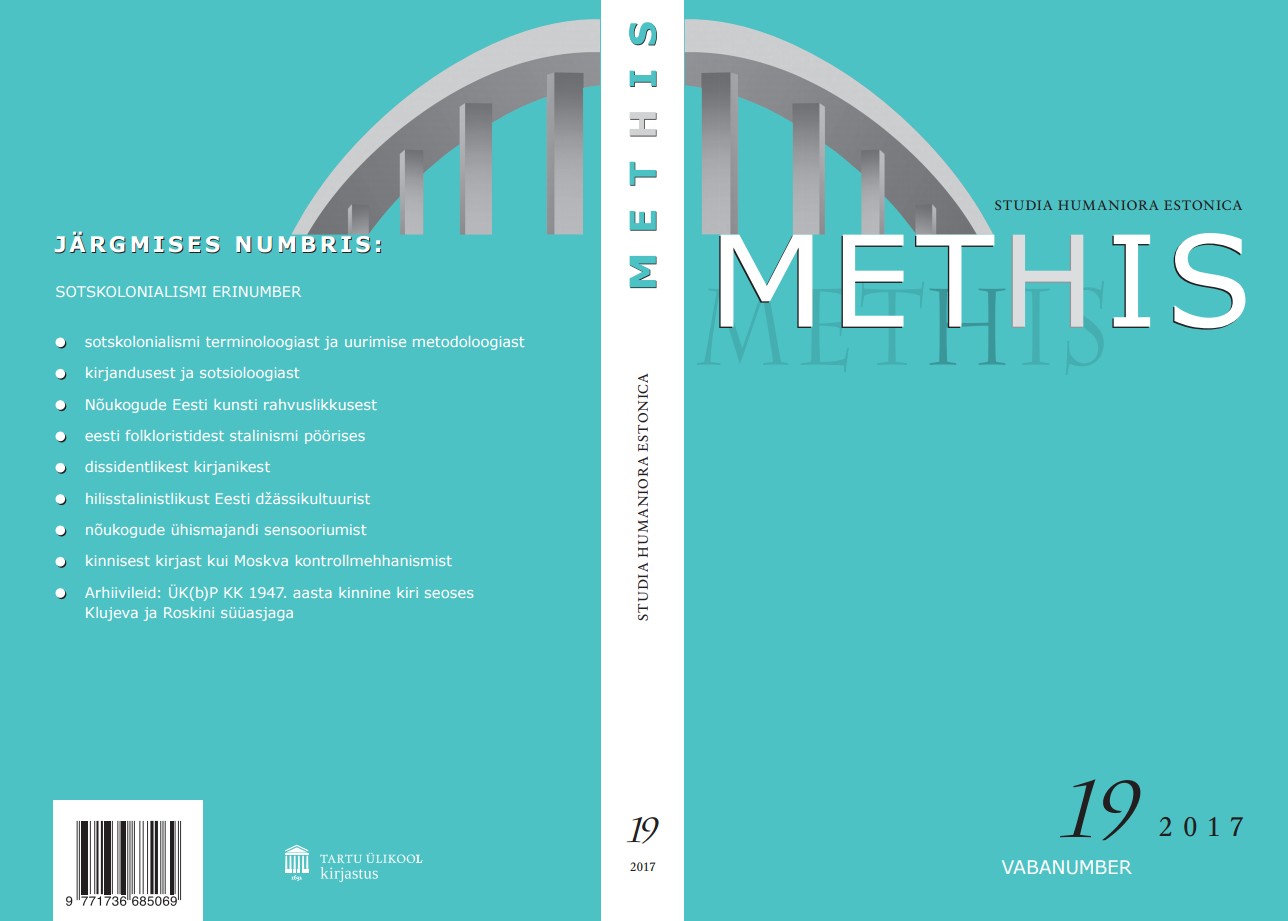Vellerismist – ühest erilisest väikevormist / About one specific minor form—Wellerism
DOI:
https://doi.org/10.7592/methis.v15i19.13435Keywords:
rahvaluule, kirjandus, Charles Dickens, vanasõnad, huumor, naljand, folklore, literature, proverbs, humour, funny folk storiesAbstract
Ütluste eritüübina määratletavat ilmingut nimega vellerism on senises eestikeelses teaduskirjanduses käsitletud napilt. Kuigi vellerismi peetakse üldiselt rahvusvaheliselt levinuks, ei saa siiski rääkida selle ühetaolisest populaarsusest kõigis keeltes ja kultuurides. Ei ole ka ühtset arusaama, millal on see väikevorm alguse saanud ning kas vellerismi algust tuleks otsida rahvaluulest või kirjandusest. Samad küsimused kerkivad ka eestikeelse vellerismi uurimisel. Artiklis annan sissevaate vellerismi kujunemisse ja käsitlustesse eri keeltes ning vaatlen seesuguste väljendite esmakordset esinemist eesti keeles vanemate allikate – kirjavahetuste, käsikirjaliste ainekogude, kalendrite, juturaamatute põhjal.
My article focusses on a phenomenon of figurative speech called Wellerism. The term originates from a work of fiction, named after the central character of Charles Dickens’s novel The Posthumous Papers of the Pickwick Club (1836–1837), Samuel Weller, who uses plenty of original expressions. Even today, the researcher of proverbs Archer Taylor is mistakenly considered to have coined the term Wellerism, although he only applied this term which had started to spread both in England and America already earlier almost simultaneously with the publishing of the novel. We have to say that already the contemporaries of Dickens noticed that the expressions, which had become popular due to this work, were nothing new as figurative minor forms—such forms had been known in different languages already much earlier. Wellerism is defined as an expression consisting, as a rule, of three parts: a saying, a speaker and an accompanying sentence or a description of the situation. Some kind of a cliché, such as a proverb, can be used as the saying. The humorous moments caused by the conflict between these two parts play a central role here.
Similar expressions to Wellerism can be dated back for centuries, and more and more studies can confirm that they are spread among almost all nations. There is still no solid understanding about the precise starting point of the phenomenon or about whether such figurative expressions can be considered as the phenomena of folklore or literature. Traditionally, Wellerism is studied as a genre belonging to the so-called minor forms of folklore (proverbs, sayings), differentiating between popular or original Wellerisms and literary or secondary Wellerisms. The study of older texts is made difficult by the scarcity of known source materials because in the German cultural space, for example, such expressions have been extremely popular since the 15th century, but the use of them in printed texts was avoided for a long time because of their crude comics and obscenity. More suitable texts for study were not published separately, but were included in publications which contained proverbs. The only common area between these two lies in the presentation of proverbs as parts of Wellerisms, but with an entirely different aim of amplifying the grotesque as the didacticism, characteristic to proverbs is overridden by mockery.
Estonian-language Wellerisms have so far not been studied, only the relations between Wellerisms and narrative creativity have been briefly touched upon. Folklorists have even claimed that there are almost no Wellerisms in Estonian folklore since the number of recorded texts is very small when compared with other short folklore forms. Resulting from the current study, we can argue that Wellerisms reached the Estonian cultural space mainly via the German language in the second half of the 19th century. This is clearly confirmed by the correspondences between the learned men of the time who discussed the subject and suggested that relying on the example of the German language, such forms should be searched for the Estonian language as well. However, such searches more often resulted in introducing Wellerisms into the Estonian language by Estophile Baltic Germans who started to publish such texts in books of popular applied literature such as calendars and in collections of stories. As expected, due to this, Wellerisms became popular and spread in the word-of-mouth communication. As the first recordings of Estonian folklore originate from about the same time, we can treat the Wellerism in Estonian folklore mostly as a short form influenced by printed literature having no original basis in folklore. Numerous examples of its relations with narratives, especially with anecdotes, allow us to talk about the Wellerism as an existing, but not too prominent folklore genre. At the same time, although the number of recordings is small, we should not believe that this short form, which is widespread in different cultures and languages of the world, is only an unimportant side phenomenon in Estonian folklore having arrived under some foreign influence. Estonian Wellerisms have had their own role in the Estonian figurative language in the past as well as they have it today.


